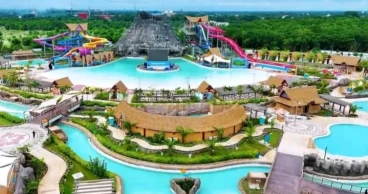Travel
Sylhet’s Jaflong Travel Guide: Where Nature’s Beauty Blooms
Sylhet, Bangladesh is a region endowed with mesmerizing natural beauty. Lush green hills, expansive tea gardens, and meandering rivers create an irresistible canvas of diversity. This Jaflong travel guide is going to highlight the spellbinding charm of this traveler’s paradise.
Origin of the Name Jaflong
The name Jaflong is steeped in the history of the Khasi people. The term "Jaflong," with its connotation of a “haat (market) of pleasure”, finds its roots in the Khasi culture.
Geographical Location of Jaflong
Jaflong is nestled at the foothills of the Khasi-Jaintia Hills, approximately 62 km to the northeast of Sylhet. These majestic mountains serve as a natural border, separating Bangladesh from India along the Meghalaya border. The surrounding region falls within the Piyain River basin in Gowainghat upazila of Sylhet district. It's through Jaflong that the Dawki River enters Bangladesh from the hills located in India.
Read more: Tinap Saitar Waterfall Travel Guide: Visit a pristine natural fountain in Bandarban
Best Time to Visit Jaflong
Jaflong's charm undergoes a captivating transformation with each season. However, it is during the rainy season that the destination is in its full glory. Those who desire to experience the beauty of this water kingdom must visit during the rainy season.
The period from June to October is the recommended period for the visit. During this time, the greenery of the mountains flourishes and becomes even more captivating, extending into November.
What to See on the Jaflong Trip
Standing knee-deep in the Piyain River and gazing upward at the verdant hills cloaked in clouds is a truly unparalleled experience. The suspension bridge is a relic from the British colonial era.
Additionally, the winding course of Dawki River, a Piyain River tributary, beckons tourists with its majestic allure.
Read more: 8 Best Winter Travel destinations in Bangladesh
The Khasia village, located just beyond the Piyain River, features unique hillside dwellings that pique the interest of thousands of tourists.
Jaflong hosts a Baishakhi fair on the first day of the Bangla New Year. Even if the occasion is the same, the banks of the river with rapid currents, surrounded by mountains, look very different compared to the crowded atmosphere of Dhaka.
Manpura Island Travel Guide: Breathtaking Paradise in Southern Bangladesh
Manpura Before 2009, Manpura was just another island on the southern edge of the Meghna River in the Bay of Bengal. Thanks to Giasuddin Selim’s Magnum Opus “Manpura” movie, the island came into the limelight. Ever since the blockbuster, there has been a growing interest in Manpura as a new travel destination.
Here’s everything you need to know about the Manpura island, how to get there, what are the attractions, and many more.
Where is Manpura island?
Manpura island is situated in the northern Bay of Bengal. It borders the exit of the Meghna River into the bay. The island is formally known as Manpura upazila under the Bhola district. It is surrounded by the two of the biggest islands of Bangladesh – Bhola and Hatia.
Read more: Tinap Saitar Waterfall Travel Guide: Visit a pristine natural fountain in Bandarban
Delhi Travel Guide: Must-see Places and Fun Activities in the Indian Capital
Standing on the bank of the Yamuna River, Delhi, India's capital territory, presents a captivating mix of history, culture, and modernity. Its strategic location, at the centre of the Indian subcontinent, has made it a bustling hub of diverse influences. And, this year, this city is one of the venues of the ICC World Cup. Delhi promises a wide range of experiences, from exploring ancient monuments to savouring delicious cuisine, along with sports excitement. Let’s take a look at this Delhi travel guide and explore the numerous facets of this fascinating metropolis.
Top 10 Famous Tourist Places to Visit in Delhi, India
Arun Jaitley Stadium
Formerly known as Feroz Shah Kotla Stadium, this cricket venue was established in 1883. Five matches of the Cricket World Cup 2023 are going to be held at this stadium located on Bahadur Shah Zafar Marg in New Delhi. Among them, the match between Bangladesh and Sri Lanka is set for November 6, 2023.
India Gate
Also known as the All India War Memorial, it stands on the side of the Rajpath in New Delhi. The 138-foot-tall historic structure was designed by British architect Sir Edwin Lutyens. A Republic Day parade is held annually around this war memorial.
Read more: Shopping in Kolkata: What to Buy and Where to Buy from
This structure is dedicated mainly to the 84,000 Indian and British soldiers who perished during the First World War and the Third Anglo-Afghan War. Engravings on the monument surface display the names of 13,300 soldiers. Local food hawkers often gather here, offering various delicacies for picnicking groups. A charming children's park is also nearby.
Qutub Minar
Known as Victory Tower, this minaret is part of the Qutub Complex in Lal Kot, Delhi. Qutub Minar's construction began in 1199 under Qutub-ud-Din Aibak. Shamsuddin Iltutmish completed the upper sections between 1199 and 1503.
Qutub Minar brilliantly merges Islamic architecture with Southwest Asian design. In 1993, UNESCO bestowed upon it the prestigious title of a World Heritage Site.
Read more: Spain Travel Guide: Top 10 Must-Visit Places
Meal served on Biman flight goes viral
After a video showing a meal served aboard a Biman Bangladesh Airlines flight emerged on TikTok, there have been mixed reactions over the alleged poor quality of the food.
Tinap Saitar Waterfall Travel Guide: Visit a pristine natural fountain in Bandarban
In the timeless melody of nature's composition, waterfalls stand as the ethereal crescendos. These are instinctive artistry, where clear streams, passing through rugged terrain, surrender to gravity's gentle embrace. Bangladesh is enriched with spectacular natural cascades. Considering the flow of water, Bandarban's Tinap Saitar is considered the largest waterfall in Bangladesh. Let's take a look at the detailed travel guide to the Tinap Saitar waterfall to experience the grandeur of this pristine natural fountain.
The Origin of Tinap Saitar’s Name
Tinap Saitar derived its name from the Bom language, in which "Tinap" translates to nasal congestion, and "Saitar" means spring or waterfall. The enigmatic juxtaposition of such a name with the breathtaking beauty of this natural wonder remains a mystery. Locals also refer to this hidden gem within the Paindu Canal as "Paindu Saitar."
Location of Tinap Saitar Waterfall
This impressive waterfall is situated within the Pindu Canal under Pindu union, under Rowangchhari upazila of Bandarban. The closest locality is Roninpara, which is located approximately 13 km away from the falls.
Read more: Khoiyachora Waterfall: Travel Guide to the Queen of the Falls in Bangladesh
Best Time to Visit the Tinap Saitar Waterfall
This waterfall reveals its grandeur during the monsoon season, when the rains swell its magnificence. Furthermore, for those seeking the rainbow's dance upon the water on sunny days, the only hope lies in the rainy season. Hence, the ideal time to visit this waterfall is between July and September, during the rainy season.
However, this adventure comes with challenges – a treacherous, slippery mountain path and waist-deep waters of the Pindu Canal. For non-swimmers, it's advisable to avoid crossing the canal.
Shopping in Kolkata: What to Buy and Where to Buy from
Travel and shopping complement each other seamlessly during travels. Purchasing souvenirs and other mementos is a delightful part of the travel experience. With its deep-rooted culture and history, Kolkata in West Bengal, India offers many distinctive items for travellers to take home and cherish. In this article, we will guide you through the best things to buy in Kolkata.
Best Souvenirs to Buy in Kolkata
Kolkata is a city synonymous with cultural richness. It is renowned for its diverse array of offerings, particularly its exquisite sarees crafted from various fabrics like cotton, silk, and muslin. Among these, the Tant, Dhakai Jamdani, and Murshidabad Silk sarees stand out. Besides these, diverse attire for women like party-wears, 3-piece salwar kameez sets, embroidered lehenga sets, etc are widely popular among tourists visiting Kolkata.
In addition to sarees, Kolkata is celebrated for its terracotta handicrafts, meticulously shaped from clay. These handicrafts come in a myriad of shapes and sizes, adorned with intricate designs.
Shola pith or sholapith (also known as shola or Indian cork), a unique reed, finds its purpose in crafting delicate figurines, masks, and jewellery. The craftsmanship involved in creating Sholapith handicrafts is awe-inspiring, making them a coveted gift item.
Conch shell bangles (also known as Shaankha) are a good choice as memorable souvenirs. Crafted from conch shells, these bangles come in various colours and sizes, suitable for any occasion. These bangles add to Kolkata's list of distinctive offerings.
Visit to Kolkata will be incomplete without indulging in this city’s delectable sweets. Rasmalai, Mishti Doi, and Sandesh, made from fresh milk and sugar, and flavoured with cardamom or saffron, present a symphony of taste. They epitomise the city's culinary excellence.
All of these showcase the city's skilled craftsmanship. Kolkata's vibrant tapestry of culture and craft beckons visitors to take home a piece of its artistic heritage and culinary delights.
Read more: Mumbai Travel Guide: Must-visit Places and Fun Activities
Home Decoration Things to Buy in Kolkata
Kolkata is revered for its diverse craftsmanship, notably its brassware. Forged from brass, a versatile metal alloy, brassware presents different shapes and sizes, often embellished with intricate designs. Incorporating brassware into your home decor can infuse an appeal of elegance.
Another prominent craft in Kolkata is woodwork, fashioned from various high-quality woods. This craftsmanship manifests in furniture, figurines, and wall hangings. They adorn your living space with warmth and sophistication. The natural beauty of wood adds a timeless charm to any home.
Khoiyachora Waterfall: Travel Guide to the Queen of the Falls in Bangladesh
Waterfalls are wonderful creations of Mother Nature. When crystal-clear water drastically flows from towering heights, its serene beauty enthralls all. Bangladesh is enriched with geographical diversity. Among the enchanting natural cascades in Bangladesh, Khoiyachora Waterfall is popular among travellers as the “queen of waterfalls” for its splendor. Let’s delve into a travel guide for Khaoiyachora Waterfall.
History of Khoiyachora Waterfall
The history of this great waterfall spans about 50 years. The area was densely forested and remote, making it challenging to discover. It is believed that the natural spring may have formed due to a mountain landslide.
The region from Baraiadhala Block to Kunder Hat is currently known as Baratakia Block. In 2010, it was officially designated as a national park, covering 2933.61 hectares of hilly land. The waterfall was then recognized as a prominent natural feature. Locals commonly refer to this spring as Chatal.
In 2017, the government initiated an eco-tourism development project to preserve this waterfall. The project covers the areas of Ramgarh, Sitakunda, and the Reserve Forest of Chattogram North Forest Division.
Read more: Most Popular Cox’s Bazar Beaches Considering Scenic Beauty and Recreation
Location of Khoiyachora Waterfall and Origin of Name
Khoiyachora is the most renowned of the springs in the Mirsharai upazila of Chattogram division. It is situated to the north of Baratakia Bazar in the Khoiyachora part along the Dhaka-Chittagong highway. Just venture about 4.2 km eastward from this highway, and this waterfall will be visible.
As the fall is nestled deep within the mountains, no vehicle can reach its base directly. First, take a CNG autorickshaw from the Dhaka-Chittagong highway to the village adjacent to the fall. From there, the only way to reach the source of the spring is on foot.
The waterfall takes its name, Khoiyachora, from the hill within the Khoiyachora union on which it is located.
Read more: The Basecamp Bangladesh in Gazipur: Adventure and Outdoor Activities near Dhaka
Nafakhum Waterfall in Bandarban: How to get to the Niagara of Bangladesh
Waterfalls are a poetry of nature, where water dances gracefully over rugged terrain. In the pristine wilderness of Bandarban, Bangladesh, lies a hidden gem that epitomizes this natural splendor — Nafakhum Waterfall. Bandarban's lush landscapes harmonize with Nafakhum's majestic cascade. It creates a symphony of serenity that beckons the wanderer's soul. Let’s start a journey to explore the breathtaking beauty of this paradise.
How the “Nafakhum” Name Came About
The origin of Nafakhum's name can be traced back to the river Remakri. In this river, a fish called "Nafa" defies the current, captured by locals as they leap and navigate the rapids.
“Khum”, in the Marma language, means waterfall. Hence, Nafakhum derives its name from the fusion of "Nafa" and "Khum."
Read more: The Basecamp Bangladesh in Gazipur: Adventure and Outdoor Activities near Dhaka
Location of Nafakhum Falls
Situated within the Remakri union in Thanchi upazila, Bandarban district, Nafakhum is located approximately 79 km from Bandarban Sadar town. Thanchi is embraced by the Sangu River, winding gently from Remakri, occasionally rising to 4 to 5 feet in some stretches. A boat journey unveils towering, cloud-kissed mountains on either side, a breathtaking sight.
Best Time to Visit Nafakhum Waterfall
Throughout the year, tourists flock to Nafakhum, yet monsoon season witnesses the Sangu River's water level surge dangerously. Hence, travel to Nafakhum is restricted during this period.
The ideal time to explore Nafakhum is post-monsoon until winter, from September to November. Even in winter, the spring water doesn't diminish the natural beauty.
Read more: Mana Bay Water Park: What does the Premium Water Park in Gazaria Offer?
The Basecamp Bangladesh in Gazipur: Adventure and Outdoor Activities near Dhaka
In the quest to break the monotony of city life, outdoor activities offer a refreshing escape. The blend of serene beauty and a rich tapestry of experiences fuels an adrenaline rush. Amidst the lush greenery of Gazipur, Dhaka, lies The Basecamp Bangladesh – an oasis of adventure and relaxation. This article provides glimpses into the outdoor escapades awaiting adventure lovers.
Founding of The Basecamp Bangladesh
This place owes its existence to the vision of its founder, Tamzid Siddiq Spondon. With a keen desire to offer an escape from urban monotony, he envisioned a place where nature, adventure, and outdoor activities seamlessly come together.
Established in 2013, Basecamp aims to entertain and provide a platform for exercise, making it the country's first outdoor activity camp.
Read more: Mana Bay Water Park: What does the Premium Water Park in Gazaria Offer?
Mana Bay Water Park: What does the Premium Water Park in Gazaria Offer?
Dhaka is one of the most densely populated cities in the world. Naturally, the scope of getaways and recreation in this concrete jungle is limited. To address this limitation, several parks and resorts are being constructed near Dhaka. Mana Bay Water Park recently started its journey as the country’s first premium water park, that is unlike anything seen before. Here’s everything you need to know about the newest attraction on the outskirts of Dhaka.
Overview of Mana Bay Water Park
Nestled in the green enclave of Gazaria, Munshiganj, Mana Bay Water Park is the country’s first and third largest premium water park in South Asia. The project has been completely funded by British investment through ACS Textiles Limited.
Mana Bay Water Park promises an unforgettable experience to its visitors while maintaining the highest level of international standard. To that end, ACS Textiles has partnered with WhiteWater for ride supply, setup, and maintenance. The entire project layout has been designed by the famous Spanish recreational design house, Amusement Logic. The park is directly supervised by Ovais Akbani and Sasheen Hasan with an overwatch from ACS Textiles Chairman Masood Dawood Akbani.
Read more: Shopping in Kathmandu: What to Buy and Where to Buy from



















